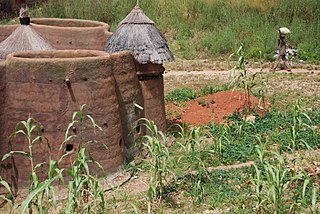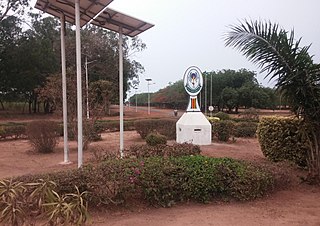
The Togolese Armed Forces is the national military of the Republic of Togo which consists of the Army, Navy, Air Force, and the National Gendarmerie. The total military expenditure during the fiscal year of 2005 was 1.6% of the country's GDP. Military bases exist in Lomé, Temedja, Kara, Niamtougou, and Dapaong. The current Chief of the General Staff is Brigadier General Titikpina Atcha Mohamed, who took office on May 19, 2009.
Hôtel du 2 Février is a luxury hotel in Lomé, Togo on Place De L'Indépendance street. It is the tallest building in Togo, standing at 102m. Because it is the only high-rise in Lomé, it is visible from just about anywhere in the city. It has 36 floors, and it was finished in 1980. It was formerly managed by the Sofitel Hôtel chain. After its nationalisation in 2014, Carlson Rezidor group took over its management. After extensive renovation work, the hotel reopened in 2016 as a Radisson Blu. However Radisson Blu is not managing the hotel since August 2017. The hotel for now runs as an independent property.

Kpalimé is a city in the Plateaux Region of Togo, 120 km north of Lomé and 15 km from the Ghanaian border. It is the administrative capital of Kloto Prefecture. Kpalimé has a population of 75,084, making it the fourth-biggest town in Togo, after Lomé, Sokodé and Kara. The town has a cathedral, a scientific lycée, and a post-office, as well as several banks, medical centres, pharmacies, cyber-cafés and petrol stations.
Kabiye is an Eastern Gurunsi Gur language spoken primarily in northern Togo. Throughout the 20th century, there was extensive emigration to the centre and south of Togo and also to Ghana and Benin. According to the Lomé statistics office, Kabiye speakers made up over 23% of the Togolese population in 1999.
Yawovi Madji Agboyibo is a Togolese politician. He served as Prime Minister of Togo from September 2006 to December 2007 and was National President of the Action Committee for Renewal (CAR), an opposition political party, from 1991 to 2008. He is the Honorary President of the CAR.

Baguida is a canton and city of the suburbs of Lomé, the capital of Togo. It was itself once the capital.
Bé is a canton and neighborhood of Lomé, Togo, located on the lagoon, east of the city. It contains a number of hotels and bars.
The Coupe du Togo is the top knockout tournament of the Togolese football.
Dékon is a neighborhood of Lomé, Togo. Although it's one of the business areas of the city, it is also one of the poorest areas, in which child prostitution is common.
Nyékonakpoé is a neighborhood of Lomé, Togo.
Tokoin is a neighborhood of Lomé, Togo. It contains the Tokoin Teaching Hospital, and Lomé–Tokoin Airport.

The Tammari people, or Batammariba, also known as Somba, are an Oti–Volta-speaking people of the Atakora Department of Benin and neighboring areas of Togo, where they go by the name of Taberma. They are famous for their two-story fortified houses, known as Tata Somba, in which the ground floor is used for housing livestock at night, internal alcoves are used for cooking, and the upper floor contains a rooftop courtyard and is used for drying grain, sleeping quarters, and granaries. These evolved by adding an enclosing roof to the clusters of huts joined by a connecting wall that are typical of Gur-speaking areas of West Africa. The Tammari are mostly animist by religion. Their language is in the Gur family.

The University of Lomé is the largest university in Togo. Located in the city of Lomé, it was founded in 1970 as University of Benin and changed its name to the University of Lomé in 2001.
Prostitution in Togo is legal and commonplace. Related activities such as solicitation, living off the earnings of prostitution or procuring are prohibited. Punishment is up to 10 years imprisonment if minors or violence is involved.

The Togo women's national football team represents the Togolese Republic in women's international football competition since 2006. Togo is managed by the Togolese Football Federation (FTF), the governing body of football in Togo. The team has played five FIFA-recognised matches, in 2006 and 2007, before reappearing in the 2018 WAFU Women's Cup, set in Abidjan, Ivory Coast. Their manager since January 2018 is Kaï Tomety. Togo's home stadium is the Stade de Kégué, located in Lomé.
The Tém an ethnic group of Togo, but also found in Benin and Ghana. There is reported to be about 417,000 of the Tém, with 339,000 in Togo, 60,000 in Ghana and 18,000 in Benin. They speak the Tem language.
The following is a timeline of the history of the city of Lomé, Togo.
The Sacred Heart Cathedral It is the mother of the Archdiocese of Lome, one of the seven Catholic church districts of the African Republic of Togo. Built in just over a year by the German colonial authorities, then it became one of the iconic buildings of the new capital of Togo.
Yves-Emmanuel Dogbé was a Togolese writer, philosopher, sociologist, and educator.








